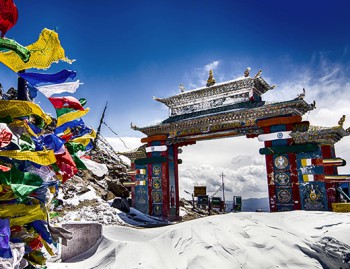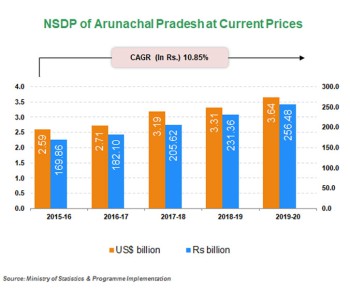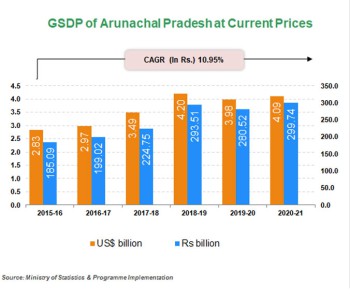INTRODUCTION
Arunachal Pradesh is the largest among the seven states located in the northeast of India, with an area of 83,743 sq kms. It shares its borders with the neighboring countries of Bhutan in the west, China (Tibet) in the north and northeast, Myanmar in the east and southeast, and the Indian states of Assam and Nagaland in the south. The geographic location of the state provides immense opportunities for international trade with South Asian countries such as Myanmar, Bhutan, and China. At current prices, the Gross State Domestic Product (GSDP) of Arunachal Pradesh is estimated to reach Rs. 299.74 lakh crore (US$ 4.25 billion) in 2020-21. The state’s GSDP will increase at a compound annual growth rate (CAGR) of 10.1% between 2015-16 and 2020-21.
The land is mostly mountainous with the Himalayan ranges. The state is divided into five river valleys – the Kameng, the Subansiri, the Siang, the Lohit, and the Tirap. These river valleys have immense hydropower potential, currently estimated at 50,328 megawatt (MW), or approximately 22% of India’s current power generating capacity. As of April 2021, the installed hydropower capacity in the state stood at 765.14 MW.
The state’s economy is largely agrarian, based on the terraced farming of rice and the cultivation of crops such as maize, millet, wheat, pulses, sugarcane, ginger, oilseeds, cereals, potato, and pineapple. In 2018-19* total horticulture production reached 190.70 thousand metric tonnes (MT).
Some of the other key industries of the state include art and crafts, weaving, cane and bamboo, horticulture, power, and mineral based industry. Due to its topography, the state has varied agro-climatic conditions suitable for horticulture of flowers, aromatic and medicinal plants. Arunachal Pradesh is home to 601 species of orchids, or 52% of the species of orchids known in India, indicating a huge potential for attracting tourists, especially foreign ones.
The state and central Governments have both offered huge fiscal and policy incentives for the development of thrust sectors in the state. Some of these policies include Public Private Partnership Policy 2011, the State Industrial Policy 2008, and the Hydro Power Policy 2008.
According to the Department for Promotion of Industry and Internal Trade (DPIIT), FDI inflows to the northeast states1 totalled US$ 142 million between April 2000 and March 2021.The state attracted FDI inflow worth US$ 5.55 million between October 2019 and March 2021.
In February 2021, the Union Government approved construction of roads measuring 598 kms with an estimated cost of ~Rs. 1,100 crore (US$ 148.29 million).



KEY SECTORS
- Power: As of April 30, 2021, Arunachal Pradesh had a total installed power-generation capacity of 765.14 MW, comprising 544.55 MW from hydro, 136.72 MW from renewable energy sources (RES) and 83.87 MW from thermal. The state has dramatically scaled up its capacity by capitalising on its hydropower potential.
- Telecom: According to the Telecom Regulatory Authority of India (TRAI), the Northeast had 12.34 million wireless and 0.09 million wireline subscribers, as of February 2021. The number of internet subscribers in the Northeast states stood at 8.72 million, as of December 2020.
- Agriculture and Forest-Based Industries: The state is largest producer of kiwis in India and the second largest producer of large cardamom. The state also has various inland fisheries resources.
- Tourism: During 2018, foreign tourist arrivals in the state reached around 7,653 while domestic tourist visits stood at 512,436. The state won the Best Emerging Tourist Destination in India award for 2019 and also the Best Emerging Green Destination of 2019.
- Textiles: Under the North East Region Textile Promotion Scheme’, 24 sericulture projects are being implemented in for holistic development of sericulture in the state. The projects have been approved for implementation from FY15-19 with a cost of Rs. 920.78 crore (US$ 127.4 million). Raw silk production in the state reached 59 MT in FY19 and 55 MT in FY20 (until January 2020). Government introduced a Gap-filling scheme in the Eri and Muga cultures worth Rs. 5 crore (US$ 676,568.00) under the state budget 2020-21 to tap potential and increase quality silk production in the state.
- Tomo Riba Institute of Health and Medical Sciences (TRIHMS), which is the first medical college in the state, was made operational and it received its first batch of fifty MBBS students in 2018. In State Budget 2020-21, Rs. 40 crore (US$ 5.67 million) has been proposed to provide as Grants-in-Aid for smooth running of the Hospital and Medical College.